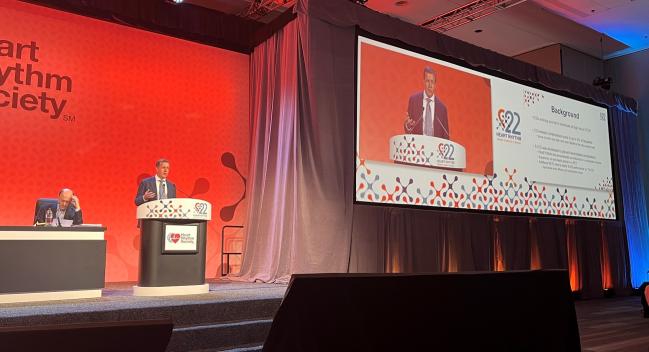Fewer Lead-Related Complications With Subcutaneous ICD: ATLAS S-ICD
This strongly supports “going extravascular for defibrillators as opposed to transvenous systems,” one expert says.

SAN FRANCISCO, CA—The subcutaneous implantable cardioverter-defibrillator (S-ICD; Boston Scientific) prevents most of the major lead-related complications seen with a transvenous system, the ATLAS S-ICD trial shows.
A composite of such outcomes had occurred in one patient who received an S-ICD and 12 who received a transvenous ICD by 6 months, a 92% relative reduction with the S-ICD (0.4% vs 4.8%; OR 0.08; 95% CI 0.00-0.55).
“It was a very clear result, and it’s a result we were hoping for and maybe even expecting,” Jeff Healey, MD (Population Health Research Institute, Hamilton, Canada), who presented the findings here at Heart Rhythm 2022, told TCTMD.
That came without a significant difference in device performance, although there was a numerically higher rate of inappropriate shocks with the S-ICD (6.4% vs 2.8%; OR 2.38; 95% CI 0.96-5.90).
Healey noted that the S-ICD is about 10 years into its development, compared with three to four decades for transvenous devices.
But even now, data from ATLAS S-ICD combined those of other studies of the S-ICD, including the randomized PRAETORIAN trial and the single-arm UNTOUCHED study, “show that this is a suitable alternative for a transvenous device, particularly in individuals where the patient and physician are strongly desiring to minimize the risk of lead complications,” he said.
Commenting for TCTMD, Daniel Cantillon, MD (Cleveland Clinic, OH), who was not involved in the trial, called the results “very exciting,” and said it provides “a very strong piece of evidence to support the benefits of going extravascular for defibrillators as opposed to transvenous systems.”
The ATLAS Trial
Transvenous ICDs have been shown to save lives in high-risk patients, but they are associated with complications that can be serious and even fatal, Healey said, noting that most of the problems arise from the intracardiac leads. The development of the S-ICD, then, would be expected to dramatically reduce complications, potentially improving long-term survival and quality of life, he added.
Two years ago at this meeting, results from two studies provided positive data for the S-ICD. PRAETORIAN showed that the S-ICD was noninferior to transvenous devices in terms of major ICD-related adverse events over 4 years, with fewer lead-related complications. And the UNTOUCHED study further supported the safety and efficacy of the S-ICD using contemporary devices and programming. But there was a lack of randomized data demonstrating the superiority of the S-ICD.
These are the kind of data that we really need when we talk to our patients. Christine Albert
For the ATLAS S-ICD trial, investigators enrolled patients ages 18 to 60 who had a standard ICD indication or adult patients with one of the following characteristics: inherited arrhythmia syndrome; prior pacemaker or ICD removal for infection; need for hemodialysis; prior heart valve surgery; or chronic obstructive pulmonary disease. Patients with an indication for biventricular pacing were excluded.
Ultimately, 503 patients (mean age 49 years; 74.2% men) were randomized and followed for an average of 2.5 years. The patient population is noteworthy, Healey said, because it is much younger on average than in previous ICD trials.
The primary outcome was major perioperative lead-related complications, a composite of hemothorax or pneumothorax; cardiac perforation, tamponade, pericardial effusion, or pericarditis; lead dislodgement or loss of pacing/sensing requiring revision; new moderate-severe or severe tricuspid insufficiency; or ipsilateral upper-extremity deep venous thrombosis. At 6 months, complications were much lower in the S-ICD arm, in which one patient had cardiac perforation, tamponade, pericardial effusion, or pericarditis.
For a composite safety outcome that included all primary outcome events plus device-related infection requiring surgical revision, significant wound hematoma requiring evacuation or interruption of oral anticoagulation, MI, stroke/TIA, or death, there was no significant difference between the S-ICD and transvenous groups at 6 months (4.4% vs 5.6%; OR 0.78; 95% CI 0.35-1.75). Although none of the differences was significant, there tended to be more add-on safety events in patients treated with the S-ICD, although Healey said that was likely due to the play of chance.
Inappropriate shocks were numerically more frequent in the S-ICD group, with an annualized rate of 2.7%, than in the transvenous group, with an annualized rate of 1.7% (HR 2.37; 95% CI 0.98-5.77). The higher rate with the subcutaneous device was driven by more cases of T-wave oversensing (six versus zero) and electromagnetic interference (five versus two). Inappropriate shocks related to atrial arrhythmias were more common with the transvenous devices (five versus two). Roughly one-quarter of all inappropriate shocks across both groups were related to electromagnetic interference from a foot massager using transcutaneous electrical nerve stimulation, Healey said, noting that these types of devices aren’t supposed to be used in patients with defibrillators.
Overall, though, inappropriate shocks occurred at low rates, Healey said, noting that annualized rates in both groups in ATLAS S-ICD come in below the rates seen with standard programming in the MADIT-RIT trial (2.9% per year). “I think through a combination of slightly better patient selection, and maybe some device innovation, these numbers can continue to go down,” he said.
There were no significant differences between groups in terms of failed first shock/arrhythmic death, all-cause mortality, heart failure hospitalization, or all-cause reoperation for the ICD or lead.
Quality of life and patient-reported outcomes will be reported at a later date, Healey said.
A Balancing Act
Discussing the results after Healey’s presentation, Christine Albert, MD (Smidt Heart Institute at Cedars-Sinai, Los Angeles, CA), a past president of the Heart Rhythm Society, said, “These are the kind of data that we really need when we talk to our patients.”
The population of ATLAS S-ICD is unique because of the mean age, she said, indicating that younger patients, who will have the devices for a longer period of time, are the ones who have the most to gain from avoiding lead complications. “I think this is a really important trial in a patient population [in which] we often are considering the S-ICD.”
The trial doesn’t answer all questions, however, and Albert said she was glad that there would be longer follow-up of these patients, which will provide information on performance over time.
Noting the numerically higher rate of inappropriate shocks with the S-ICD, Albert said “it will always be a little bit of a balancing act when we talk to our patients about which type of device to use.”
Cantillon said the increased likelihood of inappropriate shocks with the S-ICD versus transvenous systems is a legitimate issue, adding, however, that “it’s become a lesser concern as the sensing platform on which the technology is based has become a little bit more sophisticated.”
One of the major shortcomings of the current S-ICD technology, Cantillon noted, is that it doesn’t offer pacing support. But ATLAS S-ICD lays the groundwork, he added, for next-generation technology, such as that being evaluated in the MODULAR ATP trial, for which he serves as the principal investigator for North America. That is an investigational device exemption trial sponsored by Boston Scientific evaluating technology that allows a leadless pacemaker to communicate with the S-ICD, which provides the benefits of pacing without requiring transvenous leads, he said.
While awaiting those results, younger patients and those who are vulnerable to transvenous lead complications—including those on hemodialysis and others at risk for bloodstream infections—would be good candidates for the S-ICD, Cantillon said. “For younger patients requiring a defibrillator, the subcutaneous ICD has a major advantage in reducing those long-term risks of complications related to the transvenous leads,” he said.
On the other hand, patients who have either a current or possible future indication for pacing therapy would benefit from a transvenous system, Cantillon said.
Todd Neale is the Associate News Editor for TCTMD and a Senior Medical Journalist. He got his start in journalism at …
Read Full BioSources
Healey J. The ATLAS trial: avoid transvenous leads in appropriate subjects. Presented at: HRS 2022. April 30, 2022. San Francisco, CA.
Disclosures
- ATLAS S-ICD was an investigator-sponsored trial with funding from Boston Scientific.
- Healey reports receiving research grants and speaking fees from Abbott, BMS/Pfizer, Boston Scientific, Medtronic, Novartis, and Servier and consulting for Boston Scientific.
- Cantillon is the principal investigator for North America for the MODULAR ATP trial, which is sponsored by Boston Scientific.
- Albert reports research grants from Abbott, Roche Diagnostics, and St. Jude Medical.





Comments